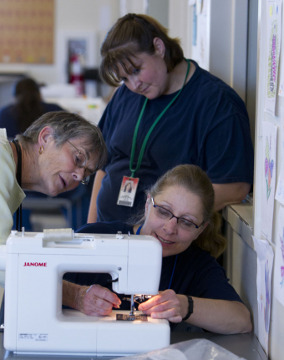
Coffee Creek Quilters teaches quilting classes to women incarcerated at the Coffee Creek Correctional Facility in Wilsonville, Oregon. Since 2002, we have provided a positive, hands-on program that gives our students an opportunity to learn and practice many life-enhancing skills.
Why teach quilting in a prison?
Quilting teaches patience, perseverance, problem-solving and the importance of quality work. When students complete their quilts, they develop a positive, “I can do it” attitude. Our goal is to nurture students’ self-esteem, so that they will be more successful living in the community after release from prison.
How many women participate?
CCQ offers four, two-hour classes a week, each with about 20 minimum-security students and five volunteer instructors. It is a popular program and there is a long waiting list. Learn more about our students and their experiences.
How does the program work?
Each student makes three quilts during 12 to 24 months in the program. The first two quilts are donated to a variety of organizations that serve hospital patients, terminally ill adults, and foster children. Each year we donate about 150 quilts. Students may keep the third quilt they make, or give it to a loved one.
Why do you donate the first two quilts?
Donating quilts lets the students give something beautiful to the community at large, an experience that few of them have ever had. When we read the women the thank-you letters from bereaved families or hospital chaplains, many are deeply moved to realize what their work has meant to others. Read some thank-yous for donated quilts.
What are the students like?
Many of our students have experienced interpersonal violence and homelessness. Most have mental health and substance abuse issues and quite a few suffer from chronic medical conditions. They almost always make amazing changes during the program. Most evolve from not being able to find a quarter-inch mark on a ruler, read a pattern or sew a straight seam to completing all three quilts.
Isn’t it complicated to teach classes in a prison, using cutting implements, sewing machines and other equipment?
It sure is. We teach the classes in CCCF’s dining room. Sewing machines, supplies, and the students’ projects are stored in locked cabinets, then quickly brought out and set up on dining tables for the classes. Students work hard because they know they only have the two-hour class time to work on their quilts.
Could a program like this be started in another correctional facility?
We’ve written a detailed guide to starting a similar program. Click on The Coffee Creek Quilters Program: A Guide for Starting Quilting Classes in Correctional Facilities.
How did Coffee Creek Quilters get started?
It began in 2002 just as the doors to Coffee Creek Correctional Facility were opened. Our founder, Koko Sutton, came up with the idea after hearing a presentation about the new facility. To learn more about CCQ’s early years, see our history page.
How does Coffee Creek Quilters operate?
CCQ is an all-volunteer organization. Our dedicated volunteers do everything, including teaching the classes, assembling quilt kits, and administering the program. We all combine a love of quilting with the desire to make a difference in the lives of our students.
Who is on the Board of Directors?
In 2025, the board is comprised of Gwen White (President), Laura Spurrell (Past President), Linda Downey (Treasurer), Joclyn Thornburg (Secretary), Linda Buckmaster, Ellen Freedman, Sandra Fresh, Eva LealLara, Diane Leveton, and Anita Sommerfeld.

